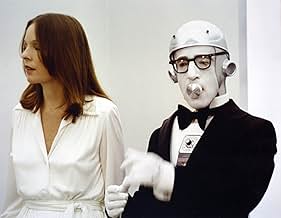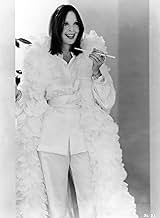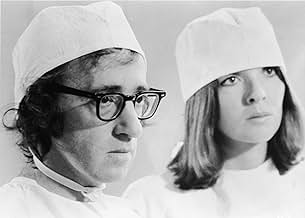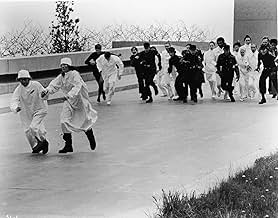NOTE IMDb
7,1/10
46 k
MA NOTE
Le propriétaire d'un magasin sort de sa cryogénie et se retrouve confronté à un futur où il doit lutter contre un gouvernement oppressif.Le propriétaire d'un magasin sort de sa cryogénie et se retrouve confronté à un futur où il doit lutter contre un gouvernement oppressif.Le propriétaire d'un magasin sort de sa cryogénie et se retrouve confronté à un futur où il doit lutter contre un gouvernement oppressif.
- Réalisation
- Scénario
- Casting principal
- Récompenses
- 2 victoires et 2 nominations au total
Mews Small
- Dr. Nero
- (as Marya Small)
Stanley Ralph Ross
- Sears Swiggles
- (as Stanley Ross)
John Cannon
- Various Voice-Overs
- (voix)
- (non crédité)
Myron Cohen
- Robot Tailor
- (non crédité)
Avis à la une
Miles Monroe (director Allen), a health food store owner and jazz clarinetist, goes to a hospital for a routine operation, but something goes wrong and he is put to cryogenic sleep for over 200 years. When he is woken up in the 22nd century, the society has changed into a pleasure-addicted dictatorship. Miles is immediately pulled into revolutionary activity and soon has to flee the state police on his way to the mysterious ruler of the society. He also finds himself teaming up with an initially reluctant woman called Luna (Diane Keaton) and together they adventure through the futuristic society.
The comedic style of Sleeper is an entertaining combination of over-the-top farce and Allen's usual verbal jabs at the society of the 20th century. The silly jazz music accompanying the bumbling chase scenes evokes memories from the silent era (some scenes are even sped-up), and the old masters of slapstick have clearly been a major influence to the style. There are also many references to more modern works of science fiction, such as 2001: A Space Odyssey and Nineteen Eight-Four. Besides the funny farcical scenes, Allen gets to perform his classic neurotic worrying routine that works fine and will amuse fans of his on-screen persona.
A very notable aspect of the film is its visual style: the sets and props all look excellent. The futuristic houses, round vehicles, stiff servant robots, gigantic fruits and even an unruly pudding look hilarious and the many details of the society provide chances to comment on how things are advancing in our times. Be it an orgasm-machine or nonsensical poetry, they seem to suggest we are moving towards times where ignorance revels and empty pleasure-hunting is celebrated as the only correct form of bliss; it can be said that the underlying themes of Sleeper are not unlike those of Aldous Huxley's classic novel Brave New World.
Social commentary aside, Sleeper is also a very funny comedy that appeals not only to friends of Allen's neurotic shtick but also to slapstick fans and admirers of creative production design. Diane Keaton also deserves praise for her performance that features all the necessary comical energy and makes a good pairing for the protagonist Miles. In brief, I laughed out loud several times and would rank the film highly among the handful of Allen films I've seen so far. As far as sci-fi comedies go, Sleeper is a definite winner.
The comedic style of Sleeper is an entertaining combination of over-the-top farce and Allen's usual verbal jabs at the society of the 20th century. The silly jazz music accompanying the bumbling chase scenes evokes memories from the silent era (some scenes are even sped-up), and the old masters of slapstick have clearly been a major influence to the style. There are also many references to more modern works of science fiction, such as 2001: A Space Odyssey and Nineteen Eight-Four. Besides the funny farcical scenes, Allen gets to perform his classic neurotic worrying routine that works fine and will amuse fans of his on-screen persona.
A very notable aspect of the film is its visual style: the sets and props all look excellent. The futuristic houses, round vehicles, stiff servant robots, gigantic fruits and even an unruly pudding look hilarious and the many details of the society provide chances to comment on how things are advancing in our times. Be it an orgasm-machine or nonsensical poetry, they seem to suggest we are moving towards times where ignorance revels and empty pleasure-hunting is celebrated as the only correct form of bliss; it can be said that the underlying themes of Sleeper are not unlike those of Aldous Huxley's classic novel Brave New World.
Social commentary aside, Sleeper is also a very funny comedy that appeals not only to friends of Allen's neurotic shtick but also to slapstick fans and admirers of creative production design. Diane Keaton also deserves praise for her performance that features all the necessary comical energy and makes a good pairing for the protagonist Miles. In brief, I laughed out loud several times and would rank the film highly among the handful of Allen films I've seen so far. As far as sci-fi comedies go, Sleeper is a definite winner.
Sleeper was a very interesting project for Allen. He had spent time doing stand up, and up until this, his movies had been written around the jokes. With the exception of Play it Again, Sam, they were a series of sketches loosely tied into a weak plot. Sleeper was the beginning of the end of this. While the plot is somewhat "sit-com-ish", it was still there, and viewers always kept it in mind. It was also loose enough that Allen could incorporate scenes paying homage to the early silent film stars (the scene with the flying suits is my personal favorite). Miles Monroe was also a rip off from Bob Hope's cowardly hero personalities, but Allen gave it his own twist, and, in my opinion, made it much better. All in all, Allen achieved the perfect blend of slapstick and substance for those in need of a simple comedy. It lacks the depth of some of his better films, but if you want to laugh, this is for you.
Oh, and if you find it somewhat intellectually devoid, try Love and Death. It was his next film, and he added less slapstick and more highbrow comedy, as well as a little more real drama and substance.
Oh, and if you find it somewhat intellectually devoid, try Love and Death. It was his next film, and he added less slapstick and more highbrow comedy, as well as a little more real drama and substance.
Sleeper is a comedy with one of the wittiest premises I've ever seen. It is a comedy about life in the 22nd century through a neurotic Jewish Brooklynite's cynical eyes. No matter how different things are in the future, his perspective doesn't change, his wry sense of humor stays the same, happily misplaced ragtime music plays over the movie, and old-fashioned sight gags are employed complete with the occasional stepped-up film speed.
Allen has always done well playing virtually the same character in all of his movies, but his talent as an on screen comedian is milestoned in this performance. He has the brilliance to mock even the most elusive and unnoticed physical conventions of screen acting, for instance his whispering to Diane Keaton while they pose as doctors in the presence of several people close by. It's a nitpicky sense of humor that contributes greatly to the intelligence behind all of his manic goofiness.
Diane Keaton is his match, however, whereas most of his leading ladies usually aren't. In fact, I hold Diane Keaton's performance in Sleeper as her crowning achievement so far that I've seen of her, even beyond her work in the Godfather films. She delivers great laughs. Her highlight is in what is possibly the funniest scene in the entire film, which eventually involves her doing an impression of Marlon Brando. Who would think that Diane Keaton would deliver the most convincing and dead-on Brando impression one has ever seen. While we're on the subject of that particular part of that hysterical scene that I will preserve for you to see for yourself, I must say that most people, even some of the most talented comedians and office/class clowns can hardly come close to mimicking Brando's voice, expressions and mannerisms. Diane Keaton somehow nails it. In Sleeper, she gives one of the funniest performances I've ever seen from an actress. She and Allen are truly one of the funniest comic pairs I've ever seen in a movie.
What makes Sleeper so funny is not just the physical comedy but the out-of-the-box, completely unorthodox creativity behind all of the physical comedy. There is a scene where someone slips on a banana peel. But the banana peel is the size of a canoe, as is the banana and all of the electronically preserved fruits and vegetables in this particular place, and Allen is being chased by a futuristic cop and both of them are slipping repeatedly on the peel. The film has robot butlers and maids of the future, and gradually throughout the film some are introduced as robots programmed to act and speak like effeminate gay men and Brooklyn Jewish stereotypes. There is also a great amount of intellectualism and cultural knowledge in even the zaniest of humorous moments in Sleeper, and that is what makes it one of Woody Allen's funniest films and a work of true comic genius.
Allen has always done well playing virtually the same character in all of his movies, but his talent as an on screen comedian is milestoned in this performance. He has the brilliance to mock even the most elusive and unnoticed physical conventions of screen acting, for instance his whispering to Diane Keaton while they pose as doctors in the presence of several people close by. It's a nitpicky sense of humor that contributes greatly to the intelligence behind all of his manic goofiness.
Diane Keaton is his match, however, whereas most of his leading ladies usually aren't. In fact, I hold Diane Keaton's performance in Sleeper as her crowning achievement so far that I've seen of her, even beyond her work in the Godfather films. She delivers great laughs. Her highlight is in what is possibly the funniest scene in the entire film, which eventually involves her doing an impression of Marlon Brando. Who would think that Diane Keaton would deliver the most convincing and dead-on Brando impression one has ever seen. While we're on the subject of that particular part of that hysterical scene that I will preserve for you to see for yourself, I must say that most people, even some of the most talented comedians and office/class clowns can hardly come close to mimicking Brando's voice, expressions and mannerisms. Diane Keaton somehow nails it. In Sleeper, she gives one of the funniest performances I've ever seen from an actress. She and Allen are truly one of the funniest comic pairs I've ever seen in a movie.
What makes Sleeper so funny is not just the physical comedy but the out-of-the-box, completely unorthodox creativity behind all of the physical comedy. There is a scene where someone slips on a banana peel. But the banana peel is the size of a canoe, as is the banana and all of the electronically preserved fruits and vegetables in this particular place, and Allen is being chased by a futuristic cop and both of them are slipping repeatedly on the peel. The film has robot butlers and maids of the future, and gradually throughout the film some are introduced as robots programmed to act and speak like effeminate gay men and Brooklyn Jewish stereotypes. There is also a great amount of intellectualism and cultural knowledge in even the zaniest of humorous moments in Sleeper, and that is what makes it one of Woody Allen's funniest films and a work of true comic genius.
In this early comedy, Woody Allen plays Miles Monroe, a twentieth century healthfood restaurant owner and jazz clarinettist who is cryogenically frozen after surgery and awoken two centuries later. The America of 2173 is a totalitarian state ruled by an oppressive dictator, and Miles has been reanimated by a group of rebels fighting to overthrow the government. For reasons too complex to set out here, Miles is forced to go on the run disguised as a robot and finds himself falling in love with his new owner, an attractive but intellectually vacant young woman named Luna. The film recounts how Miles wins Luna over to the rebel cause and tells the story of their fight against the regime.
Unlike some of Woody's later films, this is a pure comedy. It does not try to explore philosophical issues or to analyse the human condition in the same way as, say, "Hannah and her Sisters" or "Crimes and Misdemeanours". Although I normally think of Woody as a master of verbal wit, much of the humour in "Sleeper" is physical slapstick, based upon (and no doubt deliberate homage to) the comedians of the silent era such as Charlie Chaplin or Buster Keaton. (I particularly liked the scenes where Woody is disguised as a robot and those where the villains are attempting to clone the dictator, killed in a bomb explosion, from his nose). The links with that era are reinforced by the musical score, composed by Woody himself, in a jazz/ragtime style reminiscent of the 1910s and 1920s. The sets, by contrast, are very futuristic, with the clinical glass-and-chromium look of many science-fiction films. The combination of a futuristic theme with a traditional style of comedy is doubtless why the film was advertised under the slogan "Woody Allen takes a nostalgic look at the future".
This is not, however, simply a pastiche of silent humour like the one Mel Brooks was to attempt a few years later in "Silent Movie". This being a Woody Allen film, there is also a good deal of verbal humour, particularly one-liners along the lines of "I haven't seen my analyst in 200 years. He was a strict Freudian. If I'd been going all this time, I'd probably almost be cured by now". (As that line suggests, Miles is the typical, neurotically insecure Woody Allen character). As is often the case with humorous science-fiction (such as Douglas Adams's "Hitchhiker" books), the humour is frequently used to make satirical points about twentieth-century society as seen from the viewpoint of an imagined future. Contemporary worries about our diet are neatly satirised by a joke about how the science of two hundred years hence has proved that fatty foods and smoking are actually beneficial to health whereas what we now think of as healthfoods are regarded as unhealthy. This joke has remained topical because anxiety about what we eat is, if anything,even greater today than it was in 1973. There is perhaps also a dig at seventies "radical chic" as the vacuous conformist Luna becomes an equally vacuous revolutionary. (The plot of "Sleeper" seems to owe something to another tongue-in-cheek science-fiction film from a few years earlier, "Barbarella", which also dealt with rebellion against a dictator and even featured similar "orgasmatron" machines; the star of that film, Jane Fonda, had by 1973 become Hollywood's most famous radical chic actress).
The humour of "Sleeper" is often directed against figures from the sixties and seventies- perhaps too much so, as this type of humour tends to date very quickly. Some of it is still funny (such as Diane Keaton's Marlon Brando impersonation), but some can now be difficult to understand, particularly for non-Americans. (I had no idea, for example, who Howard Cosell was- apparently he was a sports commentator). That is, however, a minor quibble. Overall, this is an entertaining film and, in places, very funny, combining successfully two very different styles of humour. 7/10
Unlike some of Woody's later films, this is a pure comedy. It does not try to explore philosophical issues or to analyse the human condition in the same way as, say, "Hannah and her Sisters" or "Crimes and Misdemeanours". Although I normally think of Woody as a master of verbal wit, much of the humour in "Sleeper" is physical slapstick, based upon (and no doubt deliberate homage to) the comedians of the silent era such as Charlie Chaplin or Buster Keaton. (I particularly liked the scenes where Woody is disguised as a robot and those where the villains are attempting to clone the dictator, killed in a bomb explosion, from his nose). The links with that era are reinforced by the musical score, composed by Woody himself, in a jazz/ragtime style reminiscent of the 1910s and 1920s. The sets, by contrast, are very futuristic, with the clinical glass-and-chromium look of many science-fiction films. The combination of a futuristic theme with a traditional style of comedy is doubtless why the film was advertised under the slogan "Woody Allen takes a nostalgic look at the future".
This is not, however, simply a pastiche of silent humour like the one Mel Brooks was to attempt a few years later in "Silent Movie". This being a Woody Allen film, there is also a good deal of verbal humour, particularly one-liners along the lines of "I haven't seen my analyst in 200 years. He was a strict Freudian. If I'd been going all this time, I'd probably almost be cured by now". (As that line suggests, Miles is the typical, neurotically insecure Woody Allen character). As is often the case with humorous science-fiction (such as Douglas Adams's "Hitchhiker" books), the humour is frequently used to make satirical points about twentieth-century society as seen from the viewpoint of an imagined future. Contemporary worries about our diet are neatly satirised by a joke about how the science of two hundred years hence has proved that fatty foods and smoking are actually beneficial to health whereas what we now think of as healthfoods are regarded as unhealthy. This joke has remained topical because anxiety about what we eat is, if anything,even greater today than it was in 1973. There is perhaps also a dig at seventies "radical chic" as the vacuous conformist Luna becomes an equally vacuous revolutionary. (The plot of "Sleeper" seems to owe something to another tongue-in-cheek science-fiction film from a few years earlier, "Barbarella", which also dealt with rebellion against a dictator and even featured similar "orgasmatron" machines; the star of that film, Jane Fonda, had by 1973 become Hollywood's most famous radical chic actress).
The humour of "Sleeper" is often directed against figures from the sixties and seventies- perhaps too much so, as this type of humour tends to date very quickly. Some of it is still funny (such as Diane Keaton's Marlon Brando impersonation), but some can now be difficult to understand, particularly for non-Americans. (I had no idea, for example, who Howard Cosell was- apparently he was a sports commentator). That is, however, a minor quibble. Overall, this is an entertaining film and, in places, very funny, combining successfully two very different styles of humour. 7/10
We are blessed that Woody was around, making movies as interesting as this when he was.
Already with this one, he began his vast exploration of movie techniques and devices that would last 25 years or so.
The idea is simple in this one: he wanted to use film slapstick from a bygone era. How better to situate that than to move the whole picture into a future era?
We have some truly classic stuff here. The banana joke, The mirror joke. The robot pantomime. The acting out of the Jewish dinner (done in later movies too). The inflated man joke. You can find all these in any number of Keaton. Marx, Laurel & Hardy movies.
The unifying string of time travel, a romance, the leader and his nose is too weak to make this a solidly recommended outing. And it wouldn't be for a couple years until Woody cared about the cinematography at all.
I had forgotten how pretty Diane Keaton was. Very.
Ted's Evaluation -- 2 of 3: Has some interesting elements.
Already with this one, he began his vast exploration of movie techniques and devices that would last 25 years or so.
The idea is simple in this one: he wanted to use film slapstick from a bygone era. How better to situate that than to move the whole picture into a future era?
We have some truly classic stuff here. The banana joke, The mirror joke. The robot pantomime. The acting out of the Jewish dinner (done in later movies too). The inflated man joke. You can find all these in any number of Keaton. Marx, Laurel & Hardy movies.
The unifying string of time travel, a romance, the leader and his nose is too weak to make this a solidly recommended outing. And it wouldn't be for a couple years until Woody cared about the cinematography at all.
I had forgotten how pretty Diane Keaton was. Very.
Ted's Evaluation -- 2 of 3: Has some interesting elements.
Le saviez-vous
- AnecdotesWoody Allen originally intended the film to be three hours long and in two parts. The first part would have him in the present day, coping with life until his illness. And the second half would be the futuristic part. But United Artists rejected this concept.
- GaffesLuna's shoes change from high heels to flats when she crosses the lake on Miles' back (in the "raft" costume).
- Citations
Luna Schlosser: It's hard to believe that you haven't had sex for 200 years.
Miles Monroe: 204, if you count my marriage.
- ConnexionsEdited into Intimate Portrait: Diane Keaton (2001)
- Bandes originalesTill We Meet Again
(1918) (uncredited)
Music by Richard A. Whiting
Lyrics by Ray Egan
Performed by Woody Allen
Meilleurs choix
Connectez-vous pour évaluer et suivre la liste de favoris afin de recevoir des recommandations personnalisées
- How long is Sleeper?Alimenté par Alexa
Détails
- Date de sortie
- Pays d’origine
- Langues
- Aussi connu sous le nom de
- El dormilón
- Lieux de tournage
- Sculptured House - 24501 Ski Hill Drive, Golden, Colorado, États-Unis(mushroom shaped building, top of mountain on south side of I-70)
- Sociétés de production
- Voir plus de crédits d'entreprise sur IMDbPro
Box-office
- Budget
- 2 000 000 $US (estimé)
- Montant brut aux États-Unis et au Canada
- 18 344 729 $US
- Montant brut mondial
- 18 344 868 $US
Contribuer à cette page
Suggérer une modification ou ajouter du contenu manquant

Lacune principale
By what name was Woody et les robots (1973) officially released in India in English?
Répondre

































